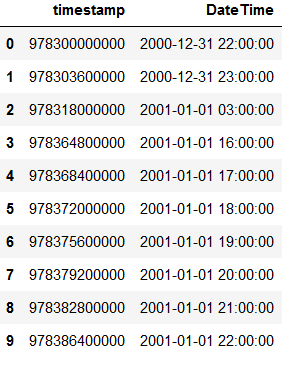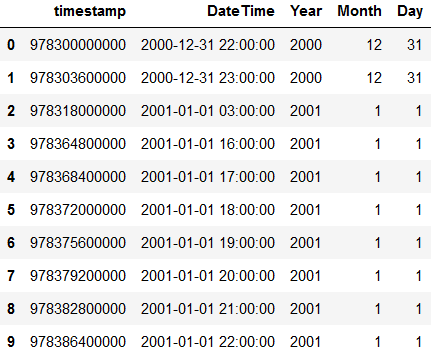1 Introduction

Let’s continue our journey through the different Analytics fields. Let’s now move on to the topic of Time Series Analysis. Most of the time we deal with cross-sectional data. Here, the data is collected at a specific point in time. On the other hand, time series data is a collection of observations obtained through repeated measurements over time. If we were to draw the points in a diagram then one of your axes would always be time.
A given time series is thought to consist of four systematic components:
- Trend, which describe the movement along the term.
- Seasonality, which is the repeating short-term cycle in the series.
- Cyclic Variations, which reflects repeated but non-periodic fluctuations.
- Noise, which are random variation in the series.
We can check these, with a decomposition plot like this one shown below:

But why is this information about Time Series Components so important to us? This information influences our choice of algorithms and the pre-processing steps necessary to develop a good predictive model.
1.1 Stationary Data
Statioary Data means, that the statistical properties of the particular process do not vary with time. It is mandatory to convert your data into a stationery format to train most time-series forecasting models. When time-series data is nonstationary, it means it has trends and seasonality patterns that should be removed.
1.2 Differencing
Differencing is the process of transforming the time series to stabilize the mean.
In addition, there are two other differencing methods:
- Trend Differencing (First- and Second-Order Differencing)
- Seasonal Differencing (First- and Second-Order Differencing for Seasonal Data)
1.3 Working with Dates and Times
We will come to the development of predictive models and all the steps involved. In this post we will first look at how to handle time series data in general.
2 Import the libraries and the data
import pandas as pd
import datetimeI have created a separate dataset for this post. You can download it from my “GitHub Repository”.
df = pd.read_csv('timestamp_df.csv', usecols=['timestamp'])
df
3 Convert timestamp to DateTime
# Convert timestamp to DateTime
# Admittedly in this example the timestamp is in a longer format than usual. Therefore the division by 1000
df['timestamp_epoch2'] = df.timestamp.astype(float)
df['new_timestamp_epoch'] = df.timestamp_epoch2 / 1000
df['new_timestamp_epoch_round'] = df.new_timestamp_epoch.round()
df['new_timestamp_epoch_round'] = df.new_timestamp_epoch_round.astype(int)
df['final'] = df.new_timestamp_epoch_round.map(lambda x: datetime.utcfromtimestamp(x).strftime('%Y-%m-%d %H:%M:%S'))
df['DateTime'] = pd.to_datetime(df['final'])
df.drop(["timestamp_epoch2", "new_timestamp_epoch", "new_timestamp_epoch_round", "final"], axis = 1, inplace = True)
# Print new df
df
You can also use this syntax:
df['new_DateTime'] = df['new_timestamp_epoch_round'].apply(datetime.fromtimestamp)4 Extract Year, Month and Day
df['Year'] = df.DateTime.dt.year
df['Month'] = df.DateTime.dt.month
df['Day'] = df.DateTime.dt.day
df
5 Extract Weekday and Week
df['Weekday'] = df.DateTime.dt.day_name()
df['Week'] = df.DateTime.dt.isocalendar().week
df
6 Calculate Quarter
For calculating the quarter I defined the following function:
def get_quarter(df):
if (df['Month'] <= 3):
return 'Q1'
elif (df['Month'] <= 6) and (df['Month'] > 3):
return 'Q2'
elif (df['Month'] <= 9) and (df['Month'] > 6):
return 'Q3'
elif (df['Month'] <= 12) and (df['Month'] > 9):
return 'Q4'Let’s apply the defined function:
df['Quarter'] = df.apply(get_quarter, axis = 1)
df
7 Generate YearQuarter
Especially for visualizations I always quite like to have the YearQuarter indication. Unfortunately, we cannot access the year with the str.-function as usual. The output would look like this:
str(df['Year'])
Let’s have a look at the column types:
df.dtypes
Year is here output as int64, but as we can see there is a string containing the information for all years. But we can pull the year as an object directly from DateTime.
df['DateTime'].apply(lambda x: x.strftime('%Y'))
Since this solution works, we now do this to generate another column.
df['YearQuarter'] = df['DateTime'].apply(lambda x: x.strftime('%Y')) + df['Quarter']
df
A final check:
df.dtypes
Perfect.
This also works with any other elements from DateTime. For example month or day. Here also the order can be chosen arbitrarily. Here for example: Day, month and year
df['DateTime'].apply(lambda x: x.strftime('%d%m%Y'))
8 Filter for TimeDate
df['DateTime']
print('Oldest Date: ' + str(df['DateTime'].min()))
print('Earliest Date: ' + str(df['DateTime'].max()))
Filter by dates greater than or equal to 01.01.2001:
filter1 = df.loc[df['DateTime'] >= '2001-01-01']
filter1
Filter by dates greater than or equal to 01.01.2001 18h00:
filter2 = df.loc[df['DateTime'] >= '2001-01-01 18']
filter2
9 Conclusion
This was a smart introduction to how to handle Time Series data and how to extract more information from a Timestamp. Furthermore I went into what stationary data is and what differentiating means.